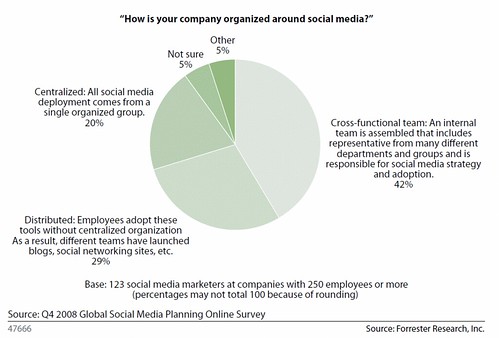Report: Companies Should Organize For Social Media in a “Hub and Spoke” model
I often get asked by brands: "How should we organize our company for social media?" or "Which roles do we need", or "Which department is in charge". So for our latest report (clients can access all the details) answers just that, it has data and graphs about spending, brand maturity in the social space, which department 'owns' the program, and how companies are organizing.
Companies organize in three distinct models
For this post, let's focus in on how companies are organizing. There are three basic models that I've observed and surveyed brands:
- The Tire (Distributed): Where each business unit or group may create its own social media programs without a centralized approach. We call this approach the “tire,” as it originates at the edges of the company.
- The Tower (Centralized): We refer to this centralization as the “tower” — a standalone group within a company that’s responsible for social media programs, often within corporate marketing or corporate communicaitons.
- The Hub and Spoke (Cross Functional): Like the hub on a bicycle wheel, a cross-functional group that represents multiple stakeholders across the company assembles in the middle of the organization. The hub facilitates resource sharing and cross-functional communications (via the “spokes” in the wheel) to those at the edge of the organization (or the “tire”)

The above graphic shows how brands we surveyed are organized
Which way should companies organize?
We believe the most sophisticated and effecient way is the Hub and Spoke, which provides centralized resources that can support business units. The business units still have the freedom and flexibility to dialog with the market –and should be in alignment with what other spokes are doing. Social doesn't impact one department –but impacts marketing, pr, product, services, support, and development –every customer touchpoint.
Remember: 80% is Strategy only 20% is Technology
On a related note, thanks to heavy collaboration with colleague Zach Hofer-Shall we've also published a report for clients on a community launch checklist. This checklist reminds brands that 80% of their success is dependent on understanding their customers, defining an objective, and assembling the right strategy that encompasses: plans, roles, process, budgets, measurement, and training –not a focus on technology.
The faster brands can realize that approaching social marketing and collaboration isn't about technology, but about process and change management the better off they are. You'll find simliar thoughts from David Armano –who's scoping out different models within their framework of social business design.
Love to hear from you: Which way is your brand organized? In a tire? tower? or hub and spoke. In my experience, I often ask stakeholders in companies to vote by raising their hands on which model they think they are –most often, not everyone agrees –but most want to evolve to hub and spoke. Try polling your internal teams to start a lively discussion.